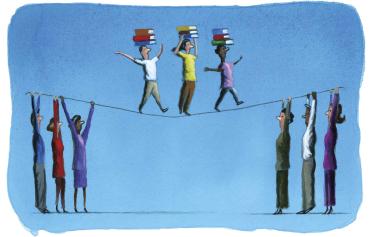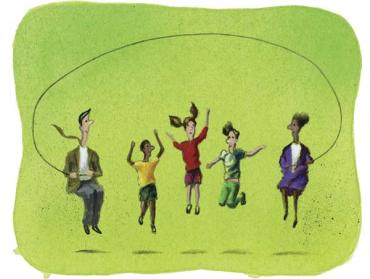“Whatever level of human capital schools acquire through hiring can subsequently be developed through activities such as grade-level or subject-based teams of teachers, faculty committees, professional development, coaching, evaluation, and informal interactions. As teachers join together to solve problems and learn from one another, the school’s instructional capacity becomes greater than the sum of its parts.”1
This quote from Harvard professor Susan Moore Johnson may make perfect sense to you. Our systems and organizations, however, are largely structured around individual values. As such, a primary goal is to optimize and reward performance at the individual level. So, while some of us (perhaps many of us) might agree that a team’s capacity can exceed the sum of individual members’ capacity, we generally have a difficult time translating that knowledge into action—for example, rewarding individual behaviors that enhance team dynamics. Part of the problem is that there’s still a lot to learn about how teamwork and collaboration are effectively nurtured.
No matter how challenging, understanding the social dynamics that underpin our work organizations seems particularly timely given the interdependent nature of the modern workplace. According to a recent Harvard Business Review article, “the time spent by managers and employees in collaborative activities has ballooned by 50% or more” over the past two decades. At many companies, employees spend more than 75 percent of their day communicating with their colleagues.2
The disconnect between what organizations need and do (i.e., collaboration and teamwork) and what they support and reward (i.e., individual performance) underscores the need to develop a better understanding of the social-relational dimension of work and work performance. What makes some groups work better than others? How does one build an effective team? Are the best teams made up by combining the “best” individuals? These questions are as important for schools and educators as they are for organizations and professionals in other fields.
A 2015 study sheds light on some of these questions.3 The researchers looked at data from various sports and demonstrated that, when a sport requires coordination among team members, having too many superstars on the team can actually hurt overall team performance. If, as indicated earlier, much of today’s work is precisely about coordination and working with others effectively, a focus on top talent may do a disservice to the team (or organization) and its performance.
But these ideas aren’t exactly new. More than a decade ago, organizational behavior experts cautioned about the pitfalls of seeking to employ only extraordinary employees, but for different reasons. If every business were to follow this strategy, they argued, we would all be headed to an escalating “war for talent.” Furthermore, in the right environment, most people can thrive and contribute meaningfully to their organization’s performance and growth. A smarter strategy would be to focus on improving work environments so that “regular” people can perform at a high level. This research offers examples of organizations that have achieved extraordinary levels of success “with people who really aren’t that much different or smarter than those working in the competition.”4
While research shows that teamwork increases organizational performance, and firms are seeking out employees who work effectively with peers, collaborative behaviors aren’t necessarily rewarded, or even monitored, in the modern workplace. In fact, the study described in the Harvard Business Review article mentioned above suggests that, while collaborators are in high demand, they feel overwhelmed and overloaded, and their good deeds often go unnoticed.
This study was conducted across more than 300 organizations and showed that those employees “seen as the best sources of information and in highest demand as collaborators in their companies ... have the lowest engagement and career satisfaction scores.” In addition, it showed that the distribution of collaborative behavior can be extremely unbalanced: “In most cases, 20% to 35% of value-added collaborations come from only 3% to 5% of employees.” And “roughly 20% of organizational ‘stars’ don’t help; they hit their numbers (and earn kudos for it) but don’t amplify the success of their colleagues.”
Paradoxically, as skilled collaborators are drawn into more and more projects and the volume and diversity of work they do with others increases, their contributions become less and less noticed. In fact, as the researchers explain, when they analyze the strongest collaborators in organizations, “leaders are typically surprised by at least half the names on their lists.” The bottom line is, if collaborators add value to the organization, they need to be recognized and protected. They are the real “organizational stars,” but they are often invisible.
Ultimately, we must learn to identify and reward employees who both perform well individually and contribute to the success of their peers. “Efficient sharing of informational, social, and personal resources should ... be a prerequisite for positive reviews, promotions, and pay raises,” the researchers say.5 Evidently, we are not there yet.
Seeing Education as a Social Endeavor
What’s now happening in schools and with educators is not so different from the picture described above. For the past two decades, teachers and their individual effectiveness have been the primary focus of education reform in the United States. Most measures of teacher effectiveness, however, ignore the social and organizational factors that are foundational to teaching quality.
There is solid evidence that strong professional environments (e.g., collaborative colleagues, a culture of trust) increase teacher effectiveness, and that teachers’ professional interactions (e.g., formal and informal social contact) with colleagues as well as teacher collaboration (e.g., lesson study and professional learning communities) produce student test score gains. While these social aspects of teaching are starting to receive some attention as a vehicle for teacher and student growth, there is still much to learn about how to understand, incentivize, support, and reward the cooperative practices and norms that would sustain reforms based on these tenets. This caution, however, should not preclude us from acting on some of what we do know; after all, the learning that needs to happen will not come from knowledge generated by research and researchers exclusively, but from experimentation with practitioners in school settings.
To take on this challenge, we need a different way of envisioning educational improvement. The social side of education reform underscores a critical oversight in the public debate on education and its policies: the idea that teaching and learning are not solo but rather social endeavors that are achieved in the context of schools and their broader school systems and communities, through relationships and partnerships rather than competition and a focus on individual prowess.
This perspective shifts the focus from the individual attributes of stakeholders (e.g., teachers, principals) to the supports and constraints afforded by the school and the broader social context in which individuals operate. It also highlights the interdependence at all levels of the system—for example, among teachers within a school, leaders across a district, schools within the community, etc.—and the idea that a complex system is more than the sum of its parts. Finally, it recognizes that valuable resources (e.g., information, advice, support) are exchanged through relationships within and across social networks, and that monitoring and strengthening this infrastructure is crucial for educational improvement.
Reviewing the Research
Context, relationships, and collaboration aren’t magic, but, as research synthesized in Teaching in Context: The Social Side of Education Reform (which I edited) shows, these factors are at least as important as individual (e.g., teacher quality) and technical (e.g., standards) aspects of improvement. In the remainder of this article, I share some findings from the book that educators and policymakers alike would do well paying attention to in order to nurture the kinds of collaborative school cultures and systems that drive and sustain improvement.
First, contrary to what has become conventional wisdom, it is not clear that teachers always “plateau” in their effectiveness after their first few years as teachers.6 Educators working in schools with strong professional environments continue to learn throughout their careers and improve at much faster rates than colleagues in schools characterized by weaker professional environments.7
Second, successful schools that serve predominantly disadvantaged students seem to have one thing in common: they use a comprehensive approach to hire, evaluate, and develop their faculties. Importantly, leaders in these schools know how to orchestrate these human and social capital systems.8
Third, not all collaboration is created equal. Both in-service and pre-service teachers improve at faster rates in schools where teachers report that collaboration is more extensive and helpful.9
Fourth, collaborative school cultures and professional relationships don’t just happen by chance. Instead, they must be facilitated and nurtured. While it’s true that you can’t force individuals to work with each other, social relations in schools are malleable and shaped by elements like job titles, organizational routines, and scheduling. Tweaking these aspects to encourage teachers to work together is possible and can produce positive results.10
Fifth, schools are not alone in how interpersonal aspects of work affect the performance of staff members. Research that has looked across settings (e.g., education, medical, and manufacturing) has established that social aspects of work are critical to the success of any type of work organization. In schools, this research has found that student performance increases dramatically when teachers have frequent and instructionally focused conversations with their peers.11
Sixth, excessive levels of personnel churn can make systems vulnerable, disrupting social relations that are critical for improvement. In their article in this issue, Alan J. Daly and Kara S. Finnigan explain how leadership churn can work to disrupt reform efforts.12
Seventh, interpersonal aspects matter across the board: among teachers, between teachers and administrators, and between school staff and the larger communities in which schools are situated. While neighborhoods influence the climate of a school, recent studies show that it can go both ways. When parents, teachers, and students work together, safety improves meaningfully in schools that serve disadvantaged communities.13
Most teachers don’t need research to be persuaded by the idea that their colleagues, as well as their school systems and communities, matter a great deal to their job performance. Educators who teach in schools characterized by supportive cultures know this firsthand; they are allowed to share their expertise with colleagues, receive support from administrators who cultivate their staff, and benefit from working in a climate of learning for students and adults.
But what about teachers who have never worked in these kinds of schools? What about educators who have experienced collaboration very differently—as another required, often inauthentic activity? And what about decision makers who are far removed from the classroom? For them, as well as educators already working in collaborative schools, Teaching in Context can serve several purposes:
- It can help them persuade policymakers that bettering the organizations where teachers work is an urgent and research-supported policy goal. For more than a decade, decision makers have focused on individual teacher accountability, neglecting to look at the social dynamics of schools and how they shape teachers’ ability to be successful with students. This research says it’s time to broaden our policy focus.
- It provides a road map on how to go from a kind of school where faculty are friendly but work independently, to a kind of school where faculty are interdependent and operate as a learning community. The book offers specific strategies, interventions, and policy proposals.
- For practitioners who know and have experienced how these things matter, it can strengthen and validate their experiences. In a context where teachers are routinely blamed for student underachievement, research that contextualizes this simplistic view, and offers concrete solutions, could be of great value to educators, inoculating them from explanations that are incomplete at best.
Clearly, individual teachers are important to educational progress, and major structural issues like poverty and inequality are tremendous challenges to educational achievement. However, when schools and school systems prioritize strengthening the interpersonal aspects of teaching and learning, even schools serving low-income students can attract, develop, and retain skillful and stable faculties and achieve good academic results. Many teachers have long known or suspected this. Now it’s time to get others on board; we cannot ignore this evidence any longer.
Esther Quintero is a senior fellow at the Albert Shanker Institute, where she conducts and synthesizes research on schools as organizations, teachers’ social capital, diversity in the teaching workforce, and the sociology of the classroom. She is the editor of Teaching in Context: The Social Side of Education Reform (Harvard Education Press, 2017), which further explores this topic, its research base, and policy implications.
Endnotes
1. Susan Moore Johnson, “Will Value-Added Reinforce the Walls of the Egg-Crate School?,” in The Social Side of Education Reform, ed. Esther Quintero (Washington, DC: Albert Shanker Institute, 2016), 15.
2. Rob Cross, Reb Rebele, and Adam Grant, “Collaborative Overload,” Harvard Business Review 94, nos. 1–2 (2016): 74–79.
3. Roderick I. Swaab, Michael Schaerer, Eric M. Anicich, Richard Ronay, and Adam D. Galinsky, “The Too-Much-Talent Effect: Team Interdependence Determines When More Talent Is Too Much or Not Enough,” Psychological Science 25 (2015): 1581–1591.
4. Charles A. O’Reilly III and Jeffrey Pfeffer, Hidden Value: How Great Companies Achieve Extraordinary Results with Ordinary People (Boston: Harvard Business School Press, 2000).
5. Cross, Rebele, and Grant, “Collaborative Overload.”
6. See, for example, Steven G. Rivkin, Eric A. Hanushek, and John F. Kain, “Teachers, Schools, and Academic Achievement,” Econometrica 73 (2005): 417–458; and Charles T. Clotfelter, Helen F. Ladd, and Jacob L. Vigdor, “Teacher-Student Matching and the Assessment of Teacher Effectiveness,” NBER Working Paper Series, no. 11936 (Cambridge, MA: National Bureau of Economic Research, 2006).
7. John P. Papay and Matthew A. Kraft, “Developing Workplaces Where Teachers Stay, Improve, and Succeed: Recent Evidence on the Importance of School Climate for Teacher Success,” in Teaching in Context: The Social Side of Education Reform, ed. Esther Quintero (Cambridge, MA: Harvard Education Press, 2017), 15–35.
8. Susan Moore Johnson, Stefanie K. Reinhorn, and Nicole S. Simon, “Reaping Rewards for Students: How Successful Urban Schools Systematically Invest in Teachers,” in Quintero, Teaching in Context, 37–69.
9. Matthew Ronfeldt, “Better Collaboration, Better Teaching,” in Quintero, Teaching in Context, 71–93.
10. James P. Spillane, Megan Hopkins, Tracy M. Sweet, and Matthew Shirrell, “The Social Side of Capability: Supporting Classroom Instruction and Enabling Its Improvement,” in Quintero, Teaching in Context, 95–111.
11. Carrie R. Leana and Frits K. Pil, “Social Capital: An Untapped Resource for Educational Improvement,” in Quintero, Teaching in Context, 113–129.
12. Alan J. Daly, Kara S. Finnigan, and Yi-Hwa Liou, “The Social Cost of Leadership Churn: The Case of an Urban School District,” in Quintero, Teaching in Context, 131–145.
13. Elaine M. Allensworth, “How the Organization of Schools and Local Communities Shape Educational Improvement,” in Quintero, Teaching in Context, 147–161.




